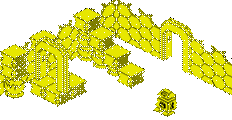Acorn Electron
Vital Statistics
Introduced
July 1983 |
![]()
What's it like today?
|
Acorn introduced the Electron in 1983 to attempt to get market share back from the likes of the Sinclair ZX Spectrum. Aiming for a retail price below £200, the Electron was pitched as a cut-down, budget version of the BBC Micro - essentially very similar but without all the expansion capabilities. It ran a MOS 6502A at 2 MHz, and came with 32K of RAM, just as with the BBC Model B.
At launch though, Electron production problems arose around the manufacturing of the complex ULA chip which was responsible for handling video output, sound, and all I/O communication, and it missed the important Christmas period in 1983. This was a blow that it never fully recovered from in the race to gain market share and widespread acceptance.
Accessories
 Acorn realised that expansion was the reason the BBC has faired so well in sales, and so they introduced the "Plus 1" expansion unit for the Electron in 1984. This unit provided the Electron with two ROM cartridge ports, a printer port, and a joystick port.
Acorn realised that expansion was the reason the BBC has faired so well in sales, and so they introduced the "Plus 1" expansion unit for the Electron in 1984. This unit provided the Electron with two ROM cartridge ports, a printer port, and a joystick port.
 Further expansion devices soon followed, with the "Plus 3" which provided a double-density 3.5" floppy disk drive connected via a WDC1770 floppy controller (the same as was used in the BBC Model B) and ADFS ROM chip . This was the first Acorn computer to support the ADFS filing system.
Further expansion devices soon followed, with the "Plus 3" which provided a double-density 3.5" floppy disk drive connected via a WDC1770 floppy controller (the same as was used in the BBC Model B) and ADFS ROM chip . This was the first Acorn computer to support the ADFS filing system.
Third-party companies such as Cumana and Slogger also produced peripherals for the Electron, including memory expansion boxes, Mode 7 display units (the Electron didn't come with Mode 7 "Teletext" as standard like the BBC had), 'Turbo' boards that allowed 2 MHz access to more of the RAM, and joystick interfaces. Slogger produced the ROMbox Plus which provided similar expansion to the Plus 1 with 2 cartridge slots but added a further 4 "sideways" ROM or RAM sockets (which supported up to 64 KB of additional RAM) and a Centronics printer port and joystick port. Cumana produced the Floppy Disk System for the Electron which came with a controller board designed to be installed into a Plus 1 or Slogger ROMbox Plus expansion slot and a 5.25" floppy disk drive. The drive supported 180 KB, 360 KB or 720 KB capacities per floppy disk.
Consumer demand for the Electron was never as high as the BBC, Spectrum or Commodore 64, and many Electrons that were built were never sold. Having said that, it sold more games throughout its product life than the BBC, and new software was still being written for the Electron into the early 1990s.











